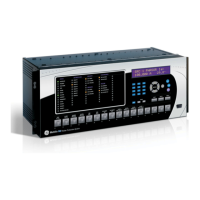5-262 F60 Feeder Protection System GE Multilin
5.7 CONTROL ELEMENTS 5 SETTINGS
5
• HI-Z LOSS OF LOAD THRESHOLD: Establishes the loss of load level used as an indication of a downed conductor. A
Loss of Load flag is set if the Hi-Z algorithms detect a percentage drop in phase current between two successive two-
cycle RMS values that equals or exceeds the Loss of Load Threshold. The amount the phase current must decrease
between successive two-cycle RMS values is based on this setting times the recent average phase current level. The
range is 5 to 100%; 5% being the most sensitive.
• HI-Z 3-PHASE EVENT THRESHOLD: Establishes the level at which the Hi-Z element characterizes a sudden three-
phase current increase as a three-phase event. The Hi-Z detection algorithms ignore the data generated by a large
three-phase event. The recommended setting is 25 A (primary).
• HI-Z VOLTAGE SUPV THRESHOLD: In the event that a fault simultaneously occurs on two adjacent feeders (line volt-
age from the same bus), the drop in line voltage will cause a subsequent drop in load current. This function will block
the Loss of Load flag from being set while the voltage is depressed. Thus, if the voltage level drops by a percentage
greater than this threshold in successive two-cycle RMS samples, the Loss of Load flag will be blocked. If the setting is
“0”, the voltage supervision function will be disabled.
• HI-Z VOLTAGE SUPV DELAY: This setting adds time delay to the voltage supervision function. Specifically, the Loss
of Load flag will continue to be blocked for the number of cycles specified by this setting.
• HI-Z EVEN HARMONIC RESTRAINT: This setting determines the level of the even harmonic at which the setting of
the overcurrent flags is inhibited. The even harmonic content is evaluated on each phase current as a percentage of
that phase's RMS current. The intent is to inhibit the setting of the overcurrent flags if the overcurrent is simply a surge
caused by cold-load pickup or other inrush event.
IMPORTANT NOTE REGARDING INSTALLATION: The F60 Hi-Z algorithm is adaptive in nature. The algorithm’s
internal thresholds gradually adapt to background “noise” on circuits with a moderate to high level of transient activ-
ity. For the first three to five days after installation (or after being out-of-service for a significant period), the F60 may
identify some of this noise as arcing. This should be taken into account when responding to alarms during these
type of operating periods.

